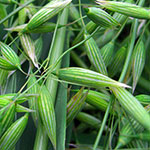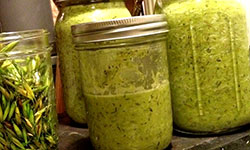Wild Oats, Common Oats, Catgrass
Avena sativa,
A. fatua
family: Poaceae

the plant: There are two or three related species of oats that we use medicinally which grow in Sonoma. Avena sativa, is the 'oatmeal' we all know, cultivated from a wild weed thousands of years ago. The other species are wilder relatives... Avena fatua is the best wild choice, although Avena barbata or 'slender oat' is also used.
Related to corn, wheat and bamboo, Oat is an annual grass that grows one to four feet high, standing on long, thin, round, hollow stems with solid swollen joints. The leaves are long, alternating and parallel-veined with open sheaths, and the seeds hang down in a diffuse panicle of spikelets.
Oats can thrive in poor soil and colder climates, and in our region they come into medicinal flower between late May and July. The meadows and  roadsides of the North Bay are covered with pale green oceans of these grassy plant allies bowing gently with the weight of their ripe seed and then turning to light golden straw.
roadsides of the North Bay are covered with pale green oceans of these grassy plant allies bowing gently with the weight of their ripe seed and then turning to light golden straw.
parts used: fresh milky immature seed, dried aerial parts (oat straw).
 preparation: strong tincture or glycerite of fresh milky tops harvested just before ripening; tea of dried green straw & tops
preparation: strong tincture or glycerite of fresh milky tops harvested just before ripening; tea of dried green straw & tops
medicinal actions: nutritive, nervine tonic, adrenal tonic, antispasmodic, vulnerary
indications: The milky unripened seed of the oat is a long-standing, beloved and premier "nerve food". This is a locally-abundant wild herbal gift for our modern culture: an essential remedy for exhaustion and prolonged stress.
It is a moistening balm for raw, adrenally-depleted nerves and can help heal the associated  malaise: anxiety and depression due to adrenal burnout… insomnia due to anxiety… tension headaches… emotional oversensitivity with outbursts of irritability & anger, or tears over the littlest things… stress-induced atonicity of the digestive tract… inability to focus and complete simple tasks along with overwhelm at a vague infinity of unfinished work that must be accomplished… loss of libido… heart palpitations… anxiety-related menstrual and menopausal imbalances… Milky Oat tops will not heal these symptoms overnight, but in time can replenish the nervous system and bring stability and renewed energy. Though it brings its own nutrition, oats pair well with lifestyle changes that invite less stress and more nourishment.
malaise: anxiety and depression due to adrenal burnout… insomnia due to anxiety… tension headaches… emotional oversensitivity with outbursts of irritability & anger, or tears over the littlest things… stress-induced atonicity of the digestive tract… inability to focus and complete simple tasks along with overwhelm at a vague infinity of unfinished work that must be accomplished… loss of libido… heart palpitations… anxiety-related menstrual and menopausal imbalances… Milky Oat tops will not heal these symptoms overnight, but in time can replenish the nervous system and bring stability and renewed energy. Though it brings its own nutrition, oats pair well with lifestyle changes that invite less stress and more nourishment.
Milky Oats is also supportive in addiction recovery and helps with the adrenal depletion caused by overuse of substances that push our energy around, like tobacco, alcohol, opiates and caffeine (almost all of humans' favorite vices!). Milky oats can be used for general debility, or nervous or sexual debility like paralysis or impotence. This medicine is also a supportive remedy when a  person has experiencedsudden loss, grief and sorrow. The flower essence supports people who feel lost in finding their path in life. Milky Oat tops combine well with adaptogens like licorice or ashwaghanda, nutritives like nettle seed and raspberry leaf, and nervines like lemon balm and skullcap.
person has experiencedsudden loss, grief and sorrow. The flower essence supports people who feel lost in finding their path in life. Milky Oat tops combine well with adaptogens like licorice or ashwaghanda, nutritives like nettle seed and raspberry leaf, and nervines like lemon balm and skullcap.
The dried stems, leaves and tops of the oat plant are also medicinal, although they do not have the nerve-food powers mentioned about fresh milky oat tops. The dried tea, often called 'oat straw', is a mineral rich nutritive containing calcium, chromium, magnesium and silica. Last but not least, a bath with oatmeal is a soothing remedy for irritated skin and neuralgia.
contraindications: safe for longterm use. oats do not have gluten but some people may be sensitive to the avenins they contain.
primary references:
• Ellingwood, Finley via Henriette Kress.
The American Materia Medica, Therapeutics and Pharmacognosy, 1919
• Hoffmann, David. Medical Herbalism
• McDonald, Jim. Nettles, Oats and You
• Moore, Michael. Medicinal Plants of the Pacific West
• Rose, Kiva. Milky Oat Monograph
• Winston, David. Adaptogens: Herbs for Strength Stamina and Stress Relief
note: This information is not a replacement for a trained herbalist. Please consult your medical professional before treating yourself or others with this or any other herbal remedy.